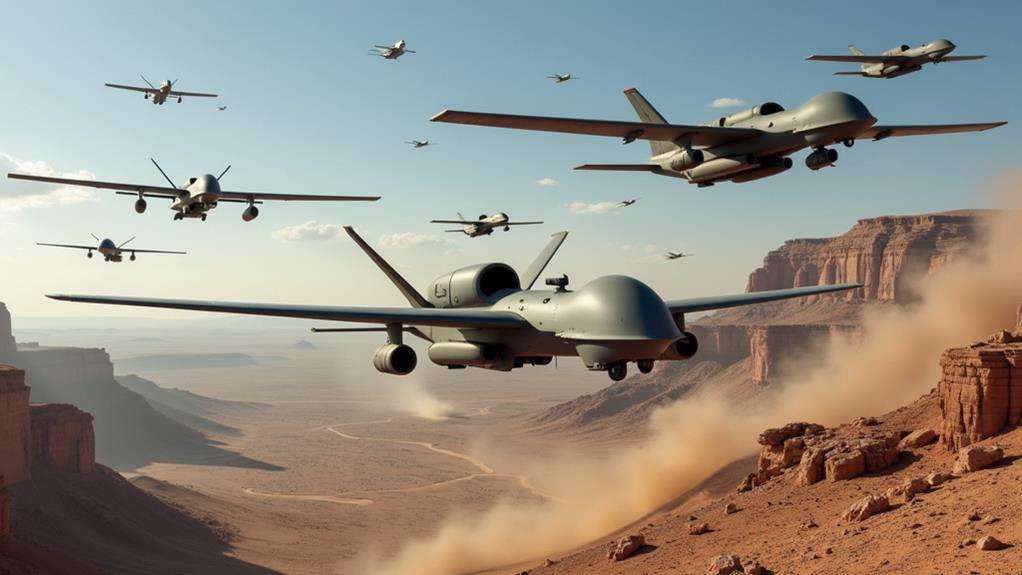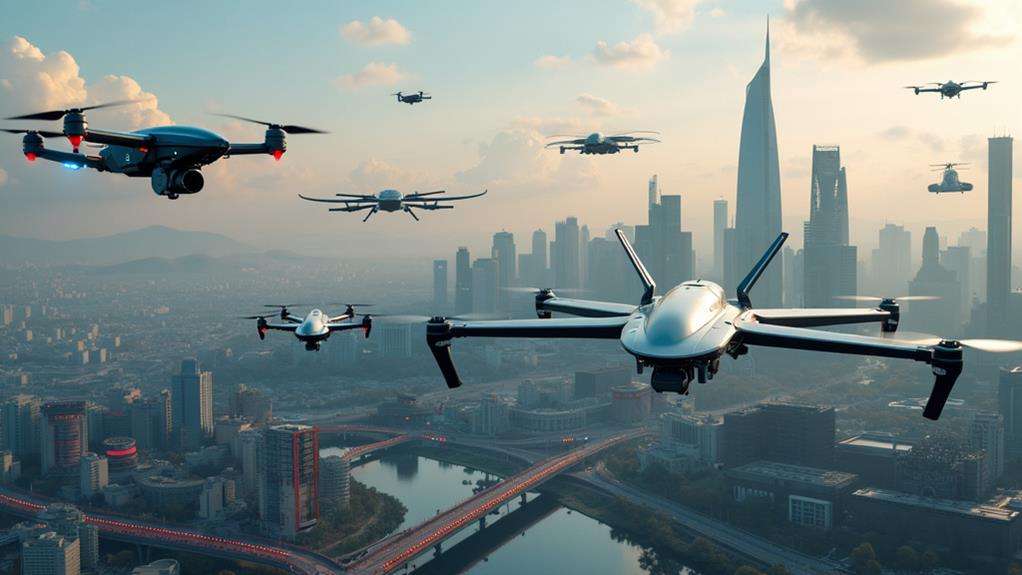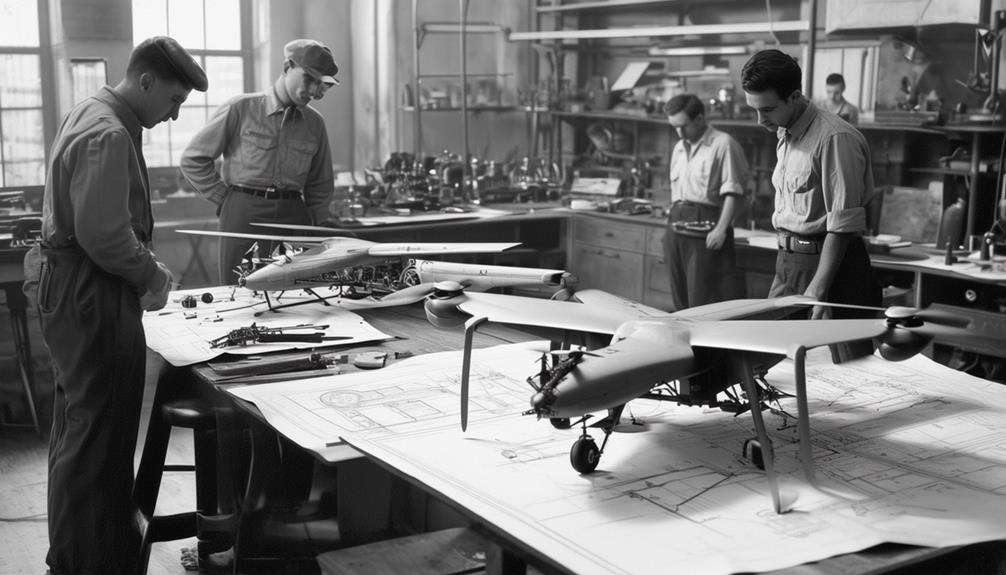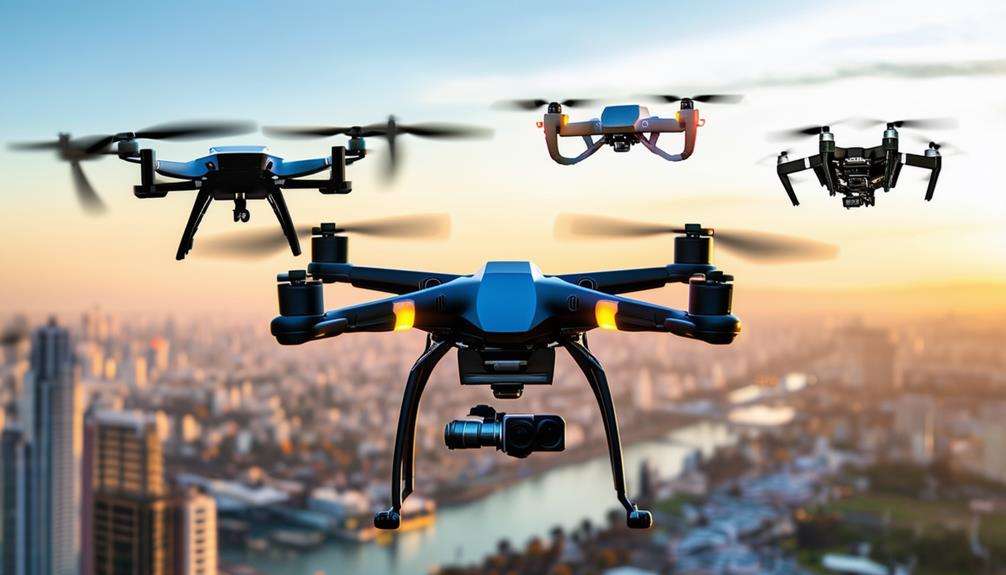Exploring the Different Types of UAVs: Fixed-Wing, Multirotor, and Hybrid

When delving into the world of UAVs, understanding the distinctions between fixed-wing, multirotor, and hybrid models is essential. Fixed-wing UAVs offer superior endurance, making them ideal for covering large areas. Conversely, multirotors are highly maneuverable, perfect for operating in confined spaces and performing short-distance tasks. Hybrid UAVs combine the strengths of both, providing a versatile solution for diverse missions. How do you choose the right type for your specific needs? Let's explore the unique characteristics and operational considerations that can significantly impact your UAV missions.
Importance of Choosing the Right Drone
Choosing the right drone is essential for maximizing operational efficiency, as each type—fixed-wing, multirotor, or hybrid—offers unique advantages tailored to specific applications and environments. When selecting a drone, it's important to consider your specific needs and operational requirements.
Fixed-wing drones excel in long-duration flights and covering large areas, making them ideal for aerial mapping and agriculture. They typically support payload capacities ranging from 500 grams to 4 kilograms and can fly for durations between 45 minutes to 24 hours.
If your tasks require precision and the ability to navigate confined spaces, multirotor drones are the better option. They are perfect for inspections and aerial photography but have limited flight times of under 1 hour, although they can carry substantial weights.
Hybrid drones combine the benefits of both fixed-wing and multirotor configurations, offering versatility in payload capacity and flight endurance. This makes them suitable for mixed-use applications.
Understanding these distinctions is crucial for selecting the right drone for your needs. Informed decision-making based on operational requirements and environmental conditions ensures that your investment in drone technology is effective and well-placed.
Overview of UAV Categories
Understanding the various UAV categories is fundamental to making an informed choice that aligns with your specific operational needs. UAVs, or Unmanned Aerial Vehicles, are broadly categorized into fixed-wing, multirotor, and hybrid types. Each category serves distinct purposes and offers unique advantages.
Fixed-wing UAVs are known for their efficiency and endurance, capable of flying for durations ranging from 45 minutes to over 24 hours. They are ideal for long-range missions, covering distances beyond 150 kilometers. These UAVs typically handle payloads between 500 grams and 4 kilograms, making them suitable for tasks requiring extended flight times and substantial coverage.
Multirotor UAVs, including popular models like quadcopters and hexacopters, excel in maneuverability and hovering capabilities. They are perfect for tasks such as aerial photography, surveying, and short-distance transportation. Multirotors generally have flight times under 30 minutes and can manage payloads up to several kilograms.
Hybrid UAVs combine the best features of both fixed-wing and multirotor designs. These versatile drones offer vertical takeoff and landing (VTOL) capabilities and achieve flight endurance of up to 10 hours. They efficiently cover large areas while carrying intermediate payloads.
Choosing the right UAV category depends on your specific operational requirements and goals.
Fixed-Wing UAV Characteristics
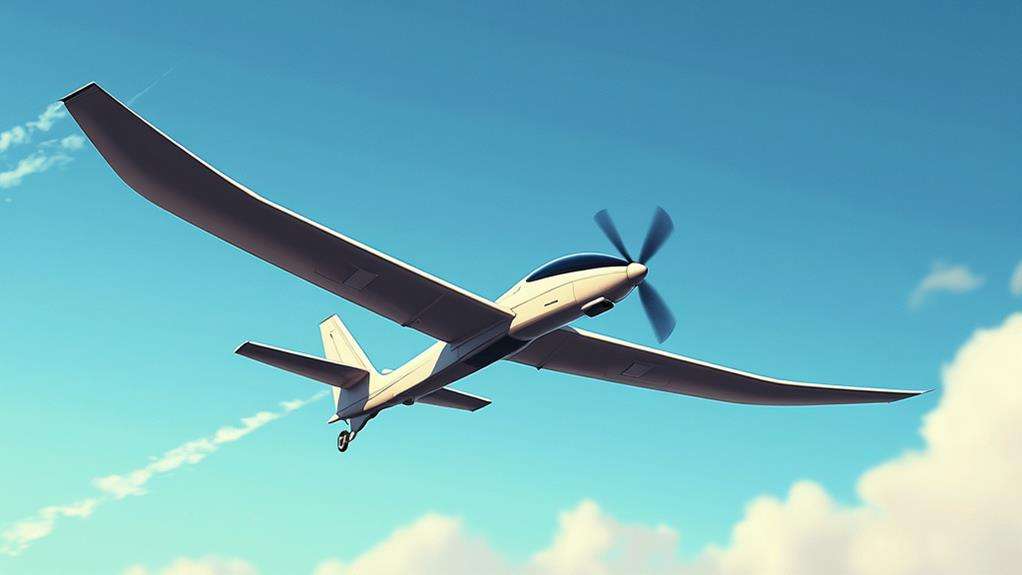
Fixed-wing UAVs are known for their impressive flight endurance and efficiency, capable of lasting from 45 minutes to over 24 hours. They can carry payloads ranging from 500 grams to 4 kilograms, making them suitable for applications such as aerial mapping and agriculture. With cruising speeds between 60 kph and 200 kph, they can efficiently cover large areas. However, they require spacious areas for takeoff and landing.
Flight Endurance and Efficiency
Fixed-wing UAVs are renowned for their exceptional flight endurance and efficiency, making them ideal for long-duration missions. These drones offer flight endurance ranging from 45 minutes to over 24 hours, enabling coverage of vast areas without frequent interruptions. With cruising speeds between 60 kph and 200 kph, they provide efficient aerial coverage over large distances.
Additionally, fixed-wing UAVs possess an impressive operational range. Many models operate beyond 25 kilometers, with some capable of reaching up to 150 kilometers. This extended range facilitates extensive surveillance or data collection, minimizing the need for frequent repositioning or recovery. Such capabilities are particularly advantageous for continuous monitoring or mapping tasks.
However, it's important to consider that fixed-wing UAVs require ample space for takeoff and landing. This necessity should be factored into flight operation planning to ensure safe launch and recovery. Despite this requirement, the superior flight endurance and efficiency of fixed-wing UAVs make them an optimal choice for long-range missions.
Payload Capacity Limits
Balancing endurance with payload capacity, fixed-wing UAVs offer a versatile yet limited carrying capability. Typically, these drones can handle payloads ranging from 500 grams to 4 kilograms. Although this may seem modest compared to multirotor drones, which can carry several dozen kilograms, fixed-wing drones excel in other crucial areas.
Fixed-wing drones are highly efficient, enabling them to cover longer distances and maintain higher cruising speeds, sometimes up to 200 kph. This efficiency makes them ideal for applications like aerial mapping and surveying, where sustained flight is crucial. However, careful planning of payload integration is essential due to their specific design and operating characteristics. Ensuring the payload is evenly distributed and securely attached is vital for maintaining flight stability and performance.
Despite their limited payload capacity, fixed-wing drones are advantageous for carrying specialized equipment. For instance, they can effectively use multispectral cameras for agricultural monitoring within their payload limits. This makes them invaluable for tasks that require both endurance and specialized data collection.
Operational Range and Speed
Fixed-wing UAVs offer significant advantages in terms of operational range and speed. These drones can operate well beyond 25 kilometers, with some models reaching up to 150 kilometers on a single flight. This extended range makes them ideal for missions requiring extensive area coverage, such as agricultural surveys, environmental monitoring, and search and rescue operations.
Their cruising speeds, ranging from 60 kph to 200 kph, enable fixed-wing UAVs to cover large areas efficiently. This speed advantage, coupled with high flight endurance—ranging from 45 minutes to over 24 hours—allows for the completion of long-duration missions without frequent recharging or refueling.
Key points to consider:
- Operational range: 25 to 150 kilometers.
- Cruising speeds: 60 kph to 200 kph.
- Flight endurance: 45 minutes to over 24 hours.
- Payload capacity: 500 grams to 4 kilograms.
- Takeoff and landing: Requires spacious areas, which can limit flexibility in confined environments.
Multirotor UAV Characteristics
Multirotor UAVs, typically equipped with 4 to 8 rotors, are designed for stability and lift, making them versatile for various applications. Despite their limited flight time of approximately 20 to 30 minutes, they are notable for their payload capacity, which ranges from a few kilograms to over 20 kilograms. Their vertical takeoff and landing capabilities make them ideal for operations in confined spaces where fixed-wing drones are unsuitable.
Design and Stability
Multirotor UAVs, including designs like quadcopters and hexacopters, typically feature 4 to 8 rotors, significantly enhancing stability and lift compared to traditional single-rotor setups. Their rotor configuration allows for vertical takeoff and landing (VTOL), making them ideal for operations in confined spaces where fixed-wing drones may struggle.
The onboard flight controller is crucial for maintaining stability. It processes inputs from various sensors, ensuring the drone remains steady even during complex maneuvers. This sophisticated control system makes multirotor UAVs highly reliable for precise applications.
Key features contributing to their design and stability include:
- High RPM propellers: Provide efficient lift and quick response times.
- Compact bodies: Enhance maneuverability and suitability for crowded environments.
- VTOL capabilities: Facilitate easy takeoff and landing in restricted areas.
- Hovering ability: Ideal for tasks requiring stationary flight, such as aerial photography.
- Limited flight endurance: Typically 20-30 minutes per charge, though some advanced models extend up to 6 hours using specialized power sources.
These characteristics make multirotor UAVs versatile for various applications.
Payload and Flexibility
Thanks to their impressive payload capacity, multirotor UAVs can carry a wide array of sensors and equipment, making them incredibly versatile for diverse applications. Typically, multirotor drones support payload capacities ranging from a few kilograms to several dozen kilograms. This enables them to be equipped with specialized payloads such as high-resolution cameras, LiDAR systems, or other sensors essential for precise data collection.
One standout feature of multirotor drones is their vertical takeoff and landing (VTOL) capability. This allows easy deployment in confined spaces where fixed-wing drones would struggle to operate. Their ability to hover adds another layer of flexibility, enabling detailed monitoring or surveying of specific areas with pinpoint accuracy.
For most survey drones, the maximum takeoff weight (MTOW) generally remains under 25 kg, ensuring manageability while still accommodating necessary equipment. Additionally, with cruising speeds typically ranging between 15 kph to 60 kph, multirotor UAVs offer controlled and accurate data acquisition during operations.
Flight Time Limitations
Many multirotor UAVs face significant flight time limitations, with most models averaging around 20-30 minutes per charge due to their power-hungry rotors. This short flight duration is primarily a result of their reliance on lithium-polymer batteries, which have a lower energy density compared to gasoline or hydrogen-powered options. Consequently, operational time is often limited before needing to recharge or swap batteries.
To mitigate these limitations and achieve extended flight durations, consider alternative power sources. Gasoline or hydrogen-powered multirotors can significantly enhance endurance, potentially extending flight times up to 6 hours.
Key factors affecting multirotor UAV flight times include:
- Battery Power: Lithium-polymer batteries offer limited energy density, constraining flight durations.
- Weight Restrictions: Maximum Takeoff Weight (MTOW) usually under 25 kg for survey applications restricts payload and impacts flight time.
- Cruising Speed: Generally ranging from 15 kph to 60 kph, affecting coverage area within limited flight time.
- Power Consumption: The more rotors, the higher the power consumption, reducing overall flight time.
- Environmental Conditions: Wind, temperature, and other factors can influence battery efficiency and flight duration.
Understanding these elements helps in making informed decisions for achieving longer and more efficient flights with your multirotor UAV.
Hybrid UAV Features
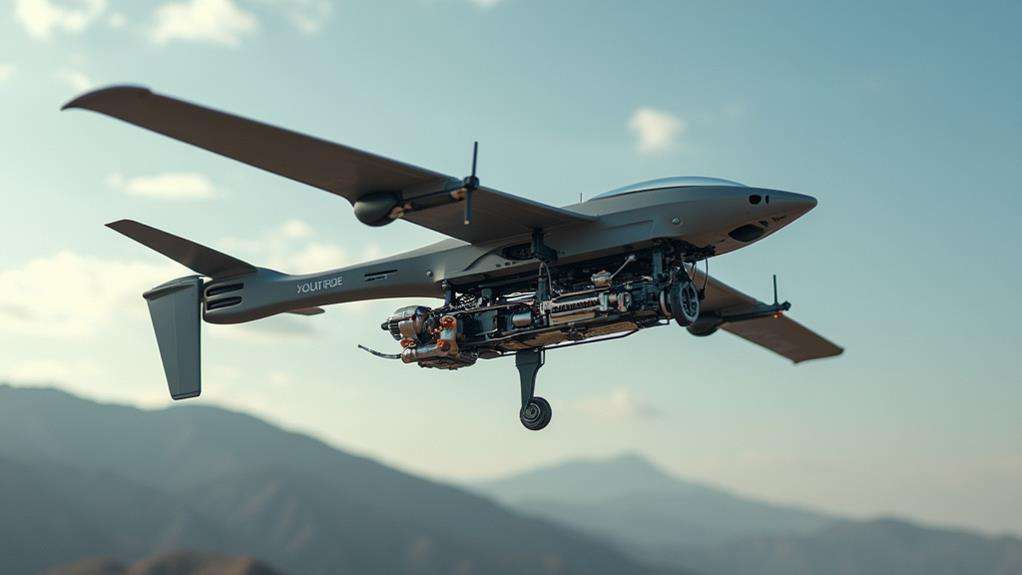
Ever wondered what makes hybrid UAVs stand out in the crowded world of drones? Hybrid UAVs combine the vertical takeoff and landing (VTOL) capabilities of rotary-wing drones with the flight endurance of fixed-wing designs. This unique combination makes them incredibly versatile for various applications, from agriculture to surveillance.
One of the standout features of hybrid UAVs is their flight endurance. Electric models can stay airborne for up to 1.5 hours, while advanced hybrids can manage an impressive 10 hours. This extended operational capability allows for the coverage of large areas without frequent recharging or refueling. Additionally, their payload capacity is greater than that of fixed-wing drones, allowing them to carry substantial equipment, though it is generally less than what multirotor drones can handle.
When it comes to cruising speeds, hybrid UAVs are on par with fixed-wing models, ensuring efficient coverage of large areas. They also maintain the ability to hover, making them perfect for precise tasks. Their operating radius is comparable to fixed-wing drones, making them suitable for large-scale missions while still allowing vertical flight in confined spaces.
Power Sources and Maintenance
Shifting focus from the impressive capabilities of hybrid UAVs, let's explore the power sources that keep these drones airborne and the maintenance required to ensure peak performance. The power sources and maintenance needs of drones are critical for ensuring they remain in optimal condition.
Power Sources:
Most drones primarily use electric batteries, with lithium-polymer (LiPo) batteries being the preferred choice due to their lightweight and rechargeable nature. Hybrid drones, however, often combine electric and gasoline power sources, allowing for extended flight durations. Some hybrid models can even stay operational for up to 10 hours.
Maintenance:
Each type of drone has specific maintenance requirements. For instance, multirotors require regular checks on their propellers and engines, while hybrid drones need more extensive upkeep due to their complex systems. Essential maintenance tasks include:
- Regularly checking the structural integrity of the drone.
- Ensuring the flight computer is functioning correctly.
- Cleaning and inspecting propellers to prevent damage.
- Monitoring battery health and replacing them as necessary.
- Servicing gasoline engines in hybrid drones to maintain efficiency.
Operational Considerations
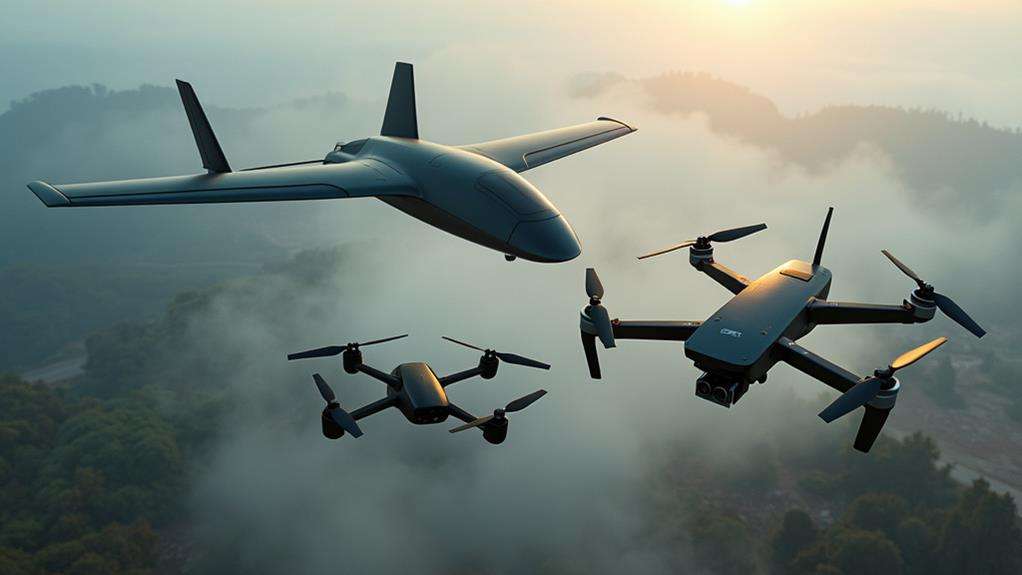
When selecting a UAV, it's essential to consider operational requirements. Fixed-wing drones, with high flight endurance (45 minutes to 24 hours) and cruising speeds of 60-200 kph, are ideal for large area coverage. However, they require ample space for takeoff and landing, limiting their operational flexibility.
Multirotor drones excel in payload flexibility and hovering capabilities, making them perfect for precise data capture in confined spaces. Their typical flight endurance is less than an hour, which can be a limitation for extended missions.
Hybrid drones combine the vertical takeoff and landing capabilities of multirotors with the extended flight endurance of fixed-wing drones. Electric hybrids can fly up to 1.5 hours, while some models can reach up to 10 hours, offering a versatile option for various operational scenarios.
Operational reliability is crucial for all UAV types and relies on regular maintenance. Consistent checks on structural integrity and flight computer functionality are essential for maximizing performance and longevity. Each drone type has distinct advantages and drawbacks, so choose based on your specific mission needs.
Application Suitability
Selecting the right UAV for your specific application is critical to achieving optimal results. Understanding the application suitability of each type—fixed-wing, multirotor, and hybrid drones—ensures that you maximize efficiency and effectiveness.
Fixed-wing drones are ideal for large area coverage and long-duration missions. Their extended flight times, often exceeding 24 hours, make them perfect for aerial mapping, agriculture, and environmental monitoring. However, their payload capacity typically ranges from 500 grams to 4 kilograms, which you should consider based on your specific needs.
Multirotor drones excel in confined or complex operational environments. If you need precise data collection for aerial photography, surveillance, or inspections, these drones are ideal. Their maneuverability and ability to hover make them indispensable in urban or densely vegetated areas, though their flight duration is usually limited to 20-30 minutes.
Hybrid drones offer a versatile middle ground, combining the endurance of fixed-wing drones with the hovering capabilities of multirotors. They are suitable for logistics, delivery services, and large-scale surveying. These drones can fly up to 10 hours and carry payloads that meet a broad range of needs.
Key Points:
- Fixed-wing drones are best for large area coverage and long-duration missions.
- Multirotor drones are ideal for confined spaces and precise data collection.
- Hybrid drones are versatile for various tasks, combining endurance and hovering capabilities.
- Flight durations and payload capacities vary across different types of drones.
Industry Use Cases
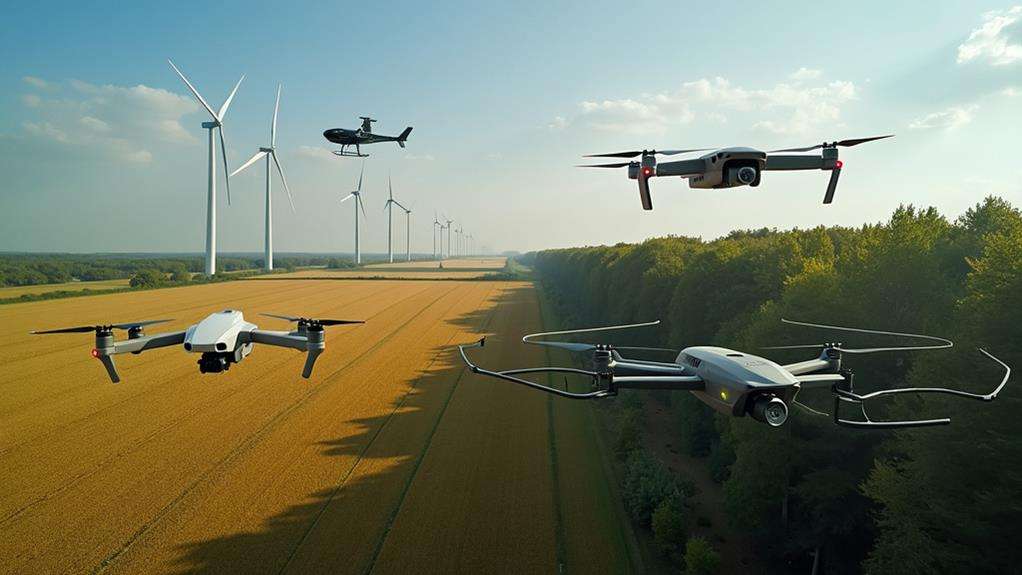
Unmanned Aerial Vehicles (UAVs) have significantly enhanced operational efficiency and data collection across various industries. In agriculture, UAVs facilitate precise crop spraying and health monitoring, with multirotor drones handling targeted tasks and fixed-wing or hybrid drones excelling in extensive land mapping and multispectral imaging for precision agriculture.
In the mining sector, multirotor drones equipped with LiDAR technology conduct detailed topographic surveys, particularly useful in confined spaces where manual methods are impractical. The real estate industry leverages both multirotor and fixed-wing drones for high-resolution aerial imagery, aiding in land design surveys, property marketing, and planning.
Utility inspections have also benefited from the deployment of multirotor and hybrid drones. These UAVs perform regular inspections of power lines and pipelines, capturing detailed data and reducing the risks associated with manual inspections. In emergency response, drones are invaluable for search and rescue operations, providing real-time situational awareness and rapidly covering extensive areas to enhance the efficiency of emergency services.
Clearly, UAVs are indispensable tools across diverse industries, offering a range of capabilities that improve precision, safety, and efficiency.

